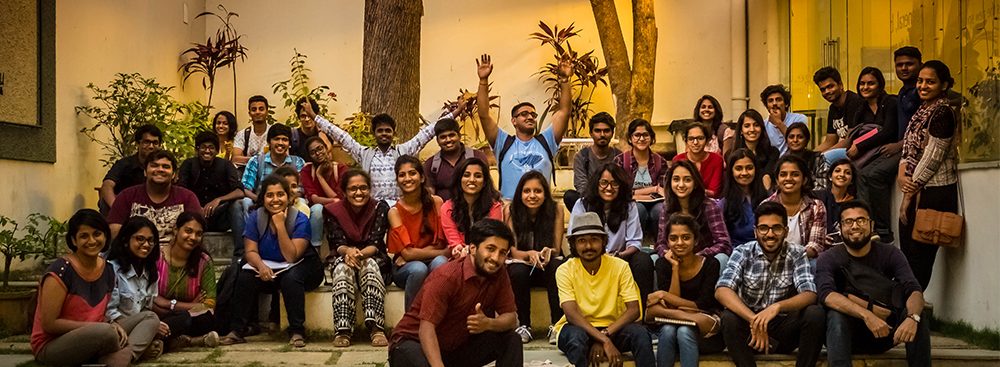
Many (dare I say most?) directors in Bangalore cut their teeth in proscenium theatres. And so, the first thing so many directors do when they walk into Jagriti is to push the action of their play right to the back of our thrust stage. When asked why, the answer is: “I need to make sure the audience on the sides doesn’t miss the action.”
Sadly, when you jam the actors up against the back wall, you not only create a very flat “tennis match” picture, but you are missing out on the tremendous power of the thrust stage. Having the actors jut into the audience creates a powerful relationship that a director can exploit to create great intimacy and connection between actors and audience; or, if the play demands it—they can create discomfort and intrusiveness. It’s hard for the audience not to be pulled in. Coupled with Jagriti’s good acoustics, you can play with almost cinematic quiet and subtlety.
In this article I talk to Jagriti’s founder and artistic director about how to deal with a thrust stage as a director. Arundhati Raja has been directing plays for the last 30 years in all kinds of spaces—from the 900-seater Chowdiah Memorial Hall, to sprawling outdoor sets at Chitra Kala Parishad, to the intimacy of Yavanika, to many combinations in the infinitely reconfigurable Alliance Francaise, and of course on the Jagriti stage.
Blocking
As much as we know that the “never turn your back to the audience” rule is bunk, I think we still remember and fear it as a childhood admonition. Even though our real-life conversations are so fractured and mutable–people getting in between, waiters looming, surrounding conversations, cell phones, other people joining in… many directors have a fear that the audience will not engage unless planted face to face with a brightly lit, clearly seen actor. The truth is that it doesn’t matter. Actors can be in shadow, they can turn away, they can even face away from sections of the audience. If done with thought and care, not only will no one miss anything, it will actually add to the performance.
Says Arundhati:
Jagriti offers the best in thrust stage work, even though the curve is more than in many such stages. It allows for dynamic blocking which offers excitement and involvement for the audience. And yet I see companies pushing themselves far upstage, keeping to the traditional “pros arch” sight lines, and the downstage curve stays empty through out, crying out to be used!
1.The main thing to remember here is that on a thrust stage, the actors can be seen from anywhere in the auditorium. There is no proscenium arch or wings to hide them.
2. The stage works best with lighter sets, as heavy furniture and props merely overshadow the actors and the space. What works well? Platforms or simple backdrops; light furniture or even nothing at all. The empty stage, however, needs excellent lighting otherwise the space can look flat and nondescript.
My mantra to all actors: “Make only meaningful movements and significant gestures or don’t move at all”. A good actor can deliver a long speech if needed with their back to the audience. But if it is used merely as a device with no real relevance to the contextual situation at that time, it will be irritating to the audience. What works best is text/situation driven movement as per the mantra.
On dealing with being so close to the audience:
If the actor is not used to working in this kind of a space, it can throw them, and here, Jagriti’s premise of more shows works well. An experienced actor can and should cope with it. With most actors in India working in a pros arch space, they initially have problems adjusting. I see though that actors who have worked in Jagriti productions and become familiar with the space use it wisely when they have come back with their own productions. Again, none of our international companies have had any such problems, using the whole space with élan!
Blocking for Jagriti:
When blocking for the Jagriti stage or any thrust stage for that matter, throw out the straight pros-arch sightlines. Use the radius/diagonals of the stage; have actors move in curves using the curve of the stage or around furniture rather in straight lines between; have actors be aware that there are people SR and SL and not play out to the central portion only.
The DSC area of the curve is ideal for scenes that call for emotion/introspection/conflict. It allows the actor/s to truly use significant gestures and move meaningfully–they are so near the audience it is even more essential.
US is great for more static situations; when required, it can be very powerful to have an actor static upstage watching a more dynamic scene happening DS.
Interpreting text
Sometimes the text chooses the space, more often, the space is given, the text has to fit. Obviously, an intimate 200-seater thrust stage is better suited to certain kinds of plays—you’re probably not going to rent Jagriti for your large-budget production of West Side Story. Even with more intimate plays, the strong character of the thrust stage adds layers to the script that you may or may not want.
Most plays can be adapted to a space (except for those above) it just requires a director to throw pre-conceived notions out the window. Our last season is a good example where all the plays produced had been performed in a pros-arch space earlier.
Cuckoo’s Nest: gave me problems initially until I myself chucked out my inhibitions and built in more movement. Furniture that had to be there was moved when necessary by the actors themselves, adding a dimension to the staging. The window was handled representationally and it worked!
Using the stairs works well in Jagriti (radials again). The DSR main door to the audi works all right if used in conjunction with the stairs and other entries. When used on its own as a single point of entry and exit, the space is immediately flattened–the old pros-arch lines again.
And finally:
It is challenging because it requires hard work on the text, looking at characters, motivation etc. This of course is true for any text in any space but here it needs more thought into WHERE exactly on the stage certain scenes work. The areas on the stage seem to have a dynamism all of their own that I have not seen on any other stage.

